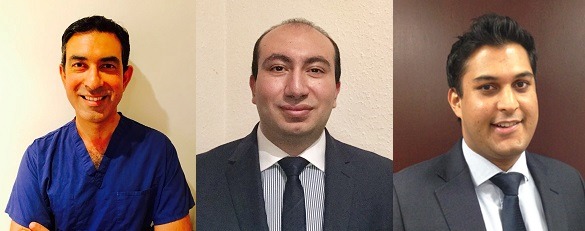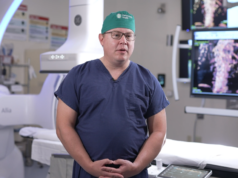
The health implications of prolonged low dose radiation exposure are frequently a topic of discussion amongst vascular interventionalists, who are performing a growing number of fluoroscopically guided procedures of increasing complexity. Anecdotal evidence points to an alarming pattern of premature, atypical malignancies in high volume operators. However, in the absence of large, prospective registries relating radiation dose to long-term health effects, a causal link with prolonged exposure cannot be established.
The standard method for measuring exposure to the operator employs personal monitors that record cumulative dose in an isolated body area, often not in real time. The safe dose limits set for occupational radiation exposure use a linear no-threshold model that assumes the risk of cancer increases in a linear manner with the exposure. Furthermore, these safe limits are extrapolated from cancers that develop after much higher dose irradiation in survivors of atomic bombs and those exposed to nuclear accidents. In truth, we know very little about the biological effects of chronic, low-dose occupational radiation exposure.
Research, carried out at the St Thomas’ Hospital Campus of the King’s Health Partners Vascular Unit and published in Circulation (B Modarai et al. Circulation 2017; doi: 10.1161/circulationaha.117.029550), shows evidence of cellular DNA damage in operators performing endovascular aneurysm repair (EVAR), particularly those carrying out complex endovascular aneurysm repair (EVAR). Bijan Modarai, Reader and Consultant Vascular Surgeon, and co-workers, Tamer El-Sayed and Ashish Patel, also found that use of shielding—especially leg shielding—seems essential protection during such cases.
DNA damage to operators was quantified by measuring the lymphocyte expression of γ-H2AX; a histone protein created by DNA double standard breaks and phosphorylated ATM (pATM); a DNA damage response marker. Lymphocytes are exquisitely radiosensitive and therefore ideal cells to use for monitoring the biological effects of exposure. Expression of γ-H2AX and pATM on lymphocytes was quantified preoperatively, immediately postoperatively and 24 hours postoperatively.
Screening time was significantly longer for complex EVAR procedures than for standard EVAR, resulting in a higher radiation dose area product (DAP) over the course of the procedure. The study showed that complex EVAR procedures were associated with higher levels of DNA damage, with a marked spike in the immediate postoperative period, before falling back to normal levels within 24 hours. Sampling of operators after standard EVAR showed a milder increase in DNA damage markers immediately postoperatively, while open repair showed no increase.
Radiation exposure to the legs is significant and appears to be a danger. Radiation was measured under a lead apron, over a lead apron, and on the legs during complex and standard EVAR. During standard EVAR, radiation under the lead apron was 0uSv (range 0–3uSv), over the lead was 11uSv (range 4–74uSv), and to the legs was 92uSv (range 43–203uSv). For complex EVAR, radiation under the lead apron was 2uSv (range 0–13uSv), over the lead was 27uSv (range 4–1504uSv), and to the legs was 145uSv (range 16–416uSv).
The induction of γ-H2AX and pATM in operators reflects these high levels of radiation exposure, with a sharp spike post-procedurally without leg pad protection.
In a separate part to the study, blood from six different operators who had not had any exposure to radiation in the previous 48 hours was collected and exposed in vitro to the same radiation dose. The expression of γ-H2AX varied on operators’ lymphocytes irradiated with the same dose, with blood from some individuals consistently producing high levels of this marker of DNA damage.
This is the first study to find evidence of cellular DNA damage in operators after performing EVAR and hints at the potential utility of a biodosimetric approach to measuring the effects of radiation exposure. Directly measuring cellular response rather than conventional dosimetry could identify operators who are prone to radiation damage and who may have a lower “safe” limit than radio-resistant operators. Factors such as age, gender, previous exposure, and diet may also impact the response to radiation. It must be stressed, however, that a greater understanding of the long-term consequences of the raised expression of γ-H2AX and pATM in irradiated lymphocytes is required before conclusions can be reached about its relationship to cancer risk.










